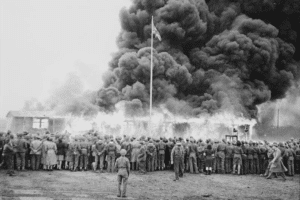
A Charred Memory: A Fragment of Bergen-Belsen at The Black Watch Museum
As the Collections Assistant at The Black Watch Museum, I spend my days surrounded by conflict-related artefacts such as medals, uniforms, letters, and photographs that
Home » Blog » Black Watch History » A tale of two Regiments and Many POW Camps!
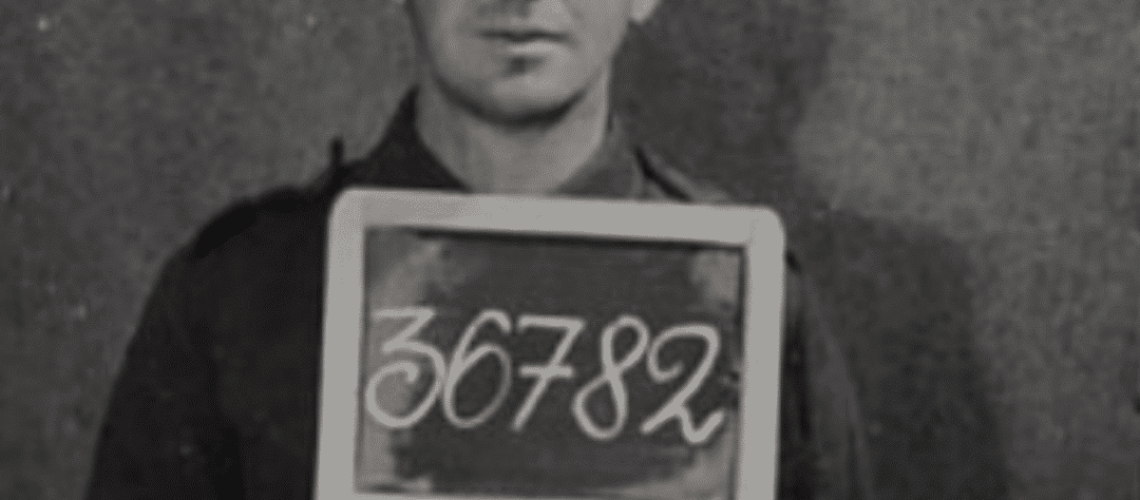
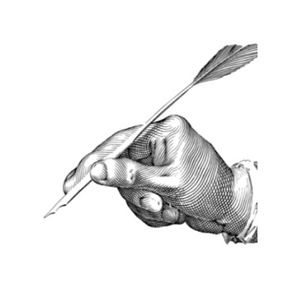
Written by David Meldrum Lowe

This is a skeletal history of my father (Pte John Murray Lowe 1904-1948, Service Number: 2976159 – POW Number: 36782) who suffered great loss in his young life, served with two of Scotland’s most famous Regiments and suffered greatly at the hands of the Germans as a POW in WW2. The information on the latter aspect of his life is somewhat sketchy, confusing and relies on German POW Records, input from the International Committee of the Red Cross (ICRC) and newspaper clippings from 1940-1943.
My Father died in 1948 when I was 9-months old and he was 44 years of age, leaving my Widowed mother to care for eight children. Alas, because I never ‘had’ a father in my life, I never really asked any questions about him over the years. Only much later in life did I become interested in Family History in general and him and his life in particular. During the past 25-years I have uncovered more about his life and death, but there are still so many things yet to discover. Indeed, only in mid-2024, at the age of 76, did I, for the first time ever, finally discover a photograph of him. I still have many unanswered questions about him and have ‘cobbled’ together a skeletal picture of his life thus far. The latter search for answers is hampered due to the fact that all of my older relatives have now passed away and sadly, there is no one left to fill in the blanks.
Nevertheless, I think that my Father, despite his short life being beset by loss, confusion and tragedy, must have been an exceptional man. It is apparent, that from a very early age he was confronted with the loss of his mother (1909), his father (1917) and his first wife and child (1927). He was born in 10 Young Street, Calton, Glasgow in 1904 to Adam and Jane Lowe (nee: Murray). Sadly, by the age of 13 he would become an Orphan and then live with various relatives in Glasgow’s East End until his first marriage in 1924. He worked for several years as a Carter in Glasgow. Unfortunately, within 3-years of his marriage, he would be mourning the passing of both his young wife and his newly-born son. This double-tragedy drove him to join the army and he enlisted in the Argyll & Sutherland Highlanders (Princess Louise’s) and was billeted at Stirling Castle with the 2nd Battalion. He undertook several interesting tours of duty, which included the West Indies (1927) and China (1929). On the latter Tour, he was awarded a Good Conduct Badge and commended for his work in collecting weekly funds from his colleagues to feed the ill, starving and dying Chinese locals. In 1932 he became ‘surplus to requirements’ and on his return to Stirling Castle, he subsequently met and married my mother. On his demob, he worked for the construction company owned by the Lord Provost of Stirling and by 1938 had four children.
Argyll & Sutherland Highlanders and The Black Watch Cap Badge


During 1939 he suffered more loss with the passing of his Father-in-Law. As a Reservist, he was recalled to the Army and posted to The Black Watch (2976159*). On the 12th June 1940 he was captured at Saint-Valery-en-Caux, France and ‘forced-marched’ and incarcerated in Stalag VI, A POW camp in Hemer, Germany and then later in many others in Germany, France and German-occupied Poland.

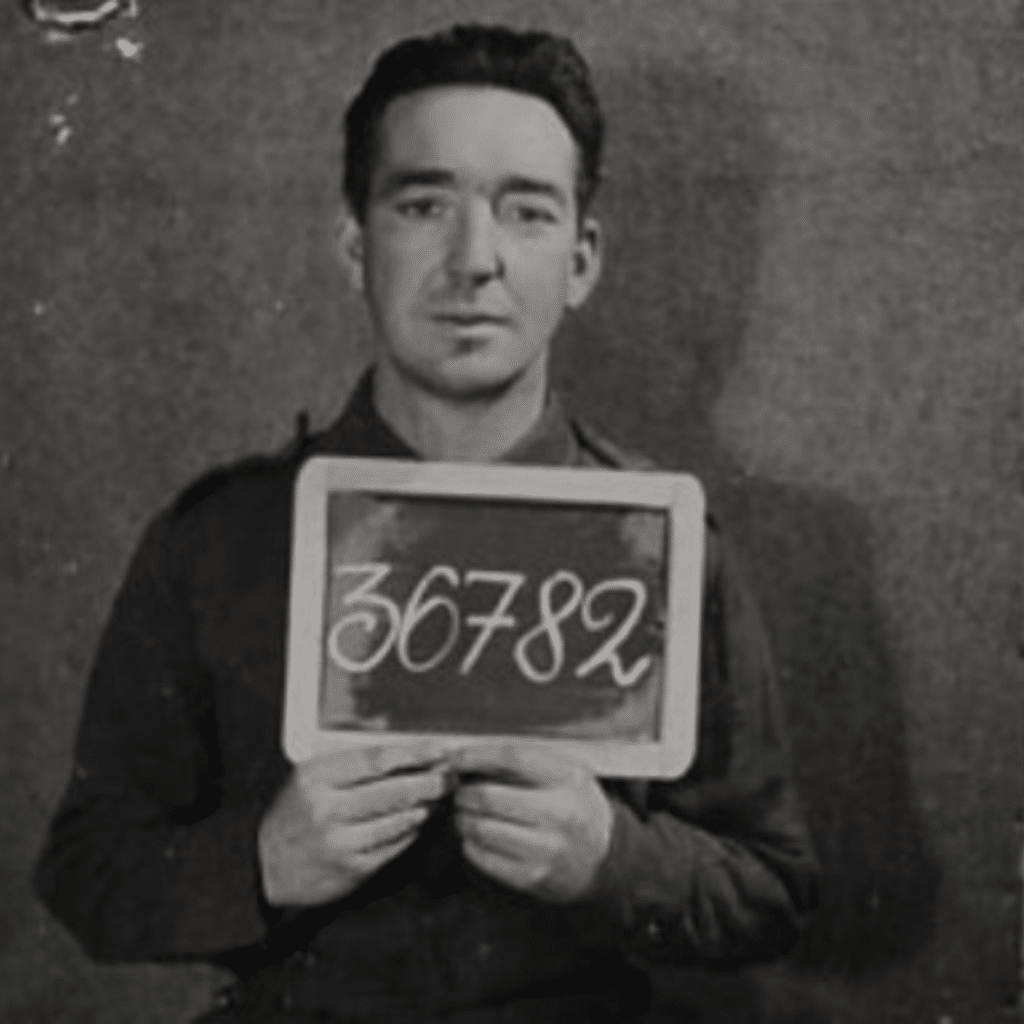
As noted above, I first set eyes on my father’s face from the strangest of sources – German POW Records, all in ‘Old German’, which I sourced from The National Archive (TNA)! With some luck, hard work and help with (some) translation, the latter, made grim reading in terms of how my father was treated during his captivity – 1940 to late-1943. He was finally repatriated (second attempt) due to ‘ill-health’ in late-October 1943.
If he had been repatriated at the earlier attempt, who knows how his life would have turned out? It is apparent, that he was shunted from POW camp to POW camp during his internment.
It is also clear that he suffered from several ailments including stomach ulcers and that he was singled-out for unfair treatment, such as being denied access to Red Cross Parcels, due to his eventual refusal to participate in any kind of work for his captors.

However, I am racing ahead of myself! It now appears that, following his capture, he was, according to the ICRC, located in Dulag VI A in Hemer, Germany, before appearing on “The Lists” (sent to ICRC by the Germans) for Stalag VI A in Hemer. The Roman Numerals in POW Camp names signifies the German Military District (i.e. 6) in which the Camps are located. Now, this is where it becomes really complicated and infuriating as it seems my Father was then transferred to Frontstalag 210 in Strassburg in France on the 2nd of October 1940. Why on earth would he be taken from Germany all the way back France? Similarly confusing is that on the 15th of December 1940 he appears on the Lists for Stalag V B (5 B) in Villingen, Germany and again on the 14th March 1941 he is Listed as being in Stalag XXI A in Ostrzeszpw in occupied Poland?

Only 2-days later on the 16th of March 1941 he was transferred yet again to Stalag XXI C/H in Wolszstyn, Poland (Wollstein -German name), an area where he appears to have been shunted around several Camps. One can perhaps assume that this was due to ‘escape attempts’ and/or ‘hospitalisation’?
On the 2nd of April that year (the ICRC note the date as 18th April?) he is on the Lists for Stalag XXI C/Z and again on the 3rd of July for Stalag XXI C. On the 7th July (8th ICRC) he is returned to Stalag XXI A and then almost immediately (8/7) transferred to Res Lazarette Schildberg (Warthegan) LKB. NR170 (Translates as “Reserve Hospital”. Was this due to the ‘worsening’ of my Father’s health?

Scottish POWs Stalag VI Hemer, Germany
According to the ICRC, some 3-months later on 13th October 1941 he was transferred back to Stalag XXI A in Wolszstyn, Poland. On the 10th April 1943 he appears on the List for Stalag XXI D in Poznan in Poland and later in Heilag Montwy (village of Matwy) in Northern Poland on the 18th June 1943. On that same day he is again transferred to Oflag 64 in the District of Schubin (Alt-Burgund), Poland.
Some 2-months later he is again transferred to Oflag 64 Z in Schokken, which was in the District of Wehrkreis XXI – Posen (Poznan), Poland. According to the ICRC, he was once again transferred on the 16th October 1943 to Stalag VIII B in Lansdorf, Poland, and then on the 18th October back to Stalag XXI in Wolszstyn, Poland. It must have been around this period that he was prepared for and finally repatriated to Scotland.


On his return to Scotland, he, along with four other repatriated colleagues, was given a ‘hero’s welcome’ culminating in an “Afternoon Tea Reception” at the Regal Cinema in Stirling, which was organised by the Lord and Lady Provost. At this Reception, the soldiers were warmly greeted and given some ‘presents’ such as cigarettes, rations and cash.
Each of the participants were invited onto the stage and were interviewed about their experiences. Seemingly, and somewhat ironically, my Father, when asked for a ‘story’ said: “I could probably tell you about Snow White and the Seven Dwarfs if that’s of any interest?”. It appears that, in terms of the ‘cash donation’, he said that he would donate this to a worthy cause (Red Cross Parcels for POWs) – strange behaviour, when you consider that his wife, my mother of four at that time, had survived for nearly five-years with little or no money! My Father went on to secure employment at the local R.E.M.E. Depot (Royal Ordinance) in Riverside, Stirling, according to his Death Certificate, was designated as an Electrician? Suffice to say that my Mother had another four children between 1944 and 1948, when Father passed away. R.I.P. John Murray Lowe.
Here is a German POW Document for John Murray Lowe showing some of the many different camps that he was incarcerated in!

Thank you to David Meldrum Lowe (Author: “KEEPING THE STORIES ALIVE: Stirlingshire & Clackmannanshire Entertainers & Venues Pre-1950 to 1989” (2021)) for

As the Collections Assistant at The Black Watch Museum, I spend my days surrounded by conflict-related artefacts such as medals, uniforms, letters, and photographs that
Just before heading up the stairs to Gallery 4 visitors will see the painting of someone who, on first glance, might not look like a
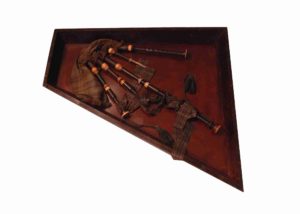
Rosie Waine is the William Grant Foundation Research Fellow at the National Museum of Scotland. Here she writes how the Black Watch Museum & Castle
